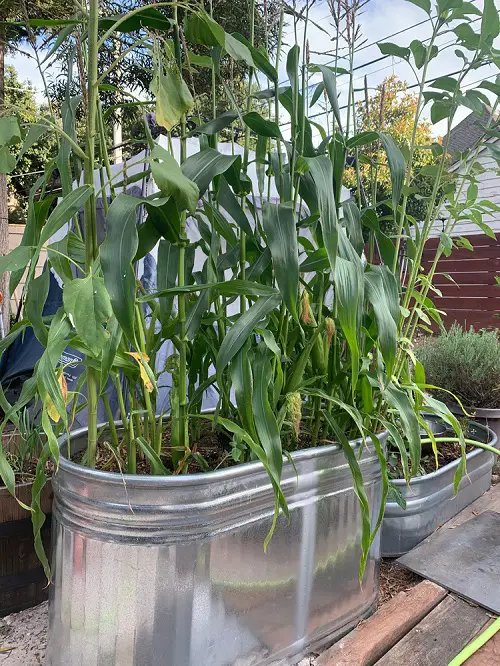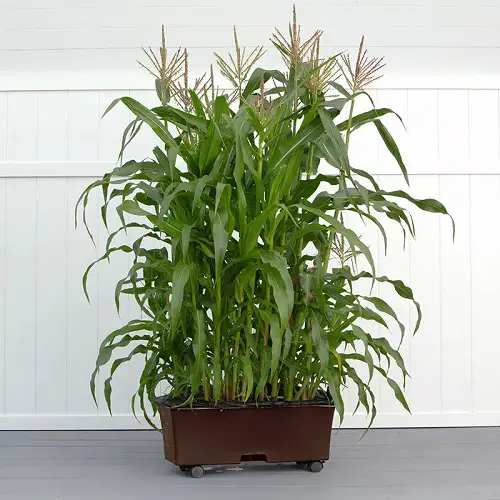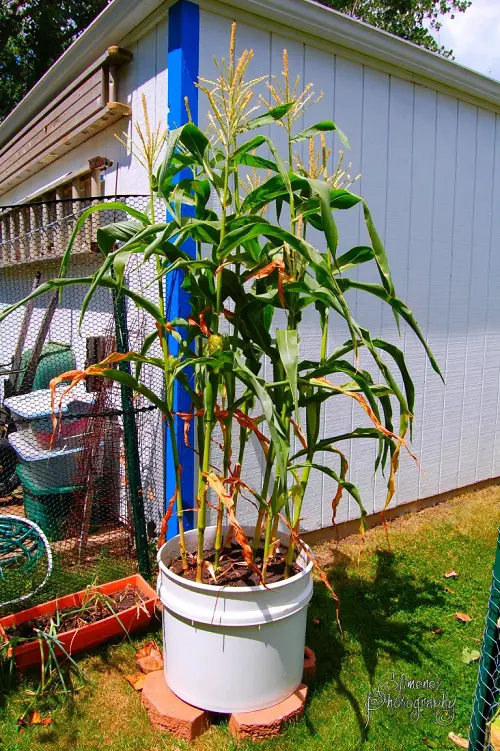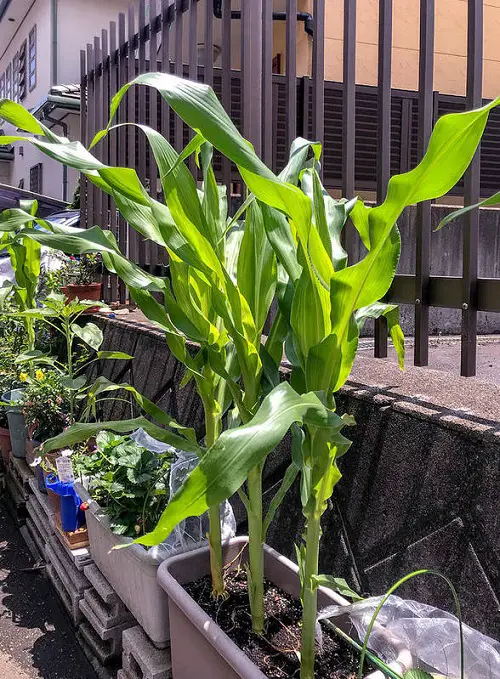Discover the world of Planting and Growing Corn in Containers, and enjoy fresh, home-grown corn all summer long, even with limited space.

Corn is a staple crop in many cultures worldwide, and while it’s traditionally grown in vast fields, you don’t need acres of land to enjoy this delicious vegetable. With the rise of container gardening, it’s easier to learn Planting and Growing Corn in Containers, even if you have limited space.
Choosing a Container to Grow Corn in Pots
It is important to know the size of the pot. Not only does container gardening offer convenience and accessibility, but it can also provide a unique and eye-catching addition to your home garden or balcony. So, let’s dive into the world of growing corn in containers and discover how you can enjoy fresh, home-grown corn all summer long!
Choose a large container that is at least 12-14 inches deep and wide. You can grow about 2-3 corn plants in this size. Make sure your pot has enough drainage holes in the bottom.
Learn How to Grow Baby Corns at Home in Pots
Planting Corn Spacing
Planting Corn Spacing depends on the type of corn being planted. For sweet corn, the general recommendation is to plant in rows that are 30-36 inches apart and to place seeds approximately 8-9 inches apart within the row.
For field corn, the general recommendation is to plant in rows that are 36-40 inches apart and to place seeds approximately 12-18 inches apart within the row.
How Tall Does Corn Grow?
It can grow tall anywhere between 5-8 feet in a container.
How Deep Does Corn Roots Grow?
They can grow as long as 5 feet when planted in the field. In containers, however, they are limited to the size of the pot used.
What Grows Well With Corn?
If you are thinking about companion planting and want to know what grows well with corn, then you can plant beans, squash, pumpkins, melons, potatoes, cucumbers, and sunflowers. These plants can help to improve the growth and productivity of corn.
Requirements to Grow Corn in a Container
Sun
Corn is a warm-season crop that requires plenty of sunlight to grow and produce a good harvest. When growing corn in containers, choose a location that receives full sun exposure for at least 5 to 7 hours daily.
If you live in a hot climate, consider providing shade during the hottest part of the day to prevent heat stress.
Soil
The best soil for corn plants is light, loamy soil that is well-draining and contains plenty of organic matter, such as compost or aged manure. The growing medium should have a pH between 6.0 and 6.8 and should also be high in phosphorus and potassium.
Water
As with most plants, corn plants should be kept evenly moist but not soggy. During the growing season, water your corn plants when the top inch of the soil is dry.
Corn plants can go a bit longer between waterings in the winter when they are not actively growing. Make sure to water your corn plants deeply so that the water reaches the roots.
Temperature
Corn plants thrive best in temperatures between 65-75°F (18-24°C) during the day and 55-65°F (13-18°C) at night.
If the temperature gets too hot, it can cause the pollen to dry out, which can reduce pollination and decrease yield. On the other hand, if the temperature drops below 60°F, the plant’s growth will slow down, and it may become susceptible to disease and pests.
Humidity
Corn plants prefer moderate to high humidity levels, between 40% to 80%. If the humidity is too low, it can cause the leaves to dry out and stunt the plant’s growth.
On the other hand, if the humidity is too high, it can increase the risk of fungal diseases and attract pests such as aphids and spider mites.
To maintain the proper humidity level, make sure to water your plants regularly, and consider using a humidifier or keeping its pot on a tray filled with pebbles and water.
Taking Care of Corn in Containers
Fertilizer
Use a balanced fertilizer with a high nitrogen content, such as 10-10-10 or 8-24-24. Dilute it to half of its strength and use it once in 3-4 weeks. Do follow the instructions on the label.
Additionally, it is important to water the plant after application.
Pests and Diseases
Pests:
1. Corn Earworm
2. Corn Borers
3. Corn Rootworms
4. Armyworms
5. Cutworms
6. European Corn Borer
7. Japanese Beetles
8. Wireworms
Diseases:
1. Corn Smut
2. Stewart’s Bacterial Wilt
3. Grey Leaf Spot
4. Northern Corn Leaf Blight
5. Common Rust
6. Southern Corn Leaf Blight
7. Fusarium Ear Rot
8. Anthracnose
To keep the pests at bay, use a neem oil solution or an insecticidal soap. To keep most of the diseases away, ensure the plant gets plenty of air circulation and sunlight. Also, avoid overwatering.
Harvesting Corn in Pots
It takes 75 to 100 days to reach maturity, depending on the variety.
The best time to harvest corn is when the kernels are full and the husks are dry, typically in late summer or early fall. Before harvesting, check the ears to make sure they are ready. To do this, peel back the husk and press a fingernail into the kernel. If it is full and milky, it is ready to be harvested.
To harvest, use a sharp knife or pruning shears to cut the stalk at the base. Leave enough of the stalk attached to the ear to be used as a handle when carrying. Ears can be picked one at a time or in bunches.
Once harvested, the ears should be husked and the kernels removed. Corn can be stored on the cob, frozen, canned, or dried for later use.






I have an old, half-wine barrel filled with potting soil and mulch. With a small backyard, I thought I would give it a try. I planted about 15 kernels and will thin to the best. I also inserted wood stakes (4) around the barrel and will put heavy cords around them as the plants grow so if a wind gets strong, hopefully, the stalks won’t blow over.
Where do I order the plants or seeds?
Do a google search and look fo No-GMO corn seeds.
You don’t need to search for “non-GMO.” Everything available to the regular consumer is non-GMO already, because you would have to sign a license agreement to purchase patented seed. And anyway, that has nothing to do with the plant being dwarf. Just search “Dwarf corn varieties” and then look for seeds.
How did the corn do? I want to plant in container this year.
I actually bought some plants and put them in a big barrel
I saw a video on growing container corn on you tube about three years ago. in one of the stages of growing grown a black fertilizer something like silt was used. my corn production was fantastic. any corn growers or farmers know what i’m referring to??????? as usual a good and foolproof system has to be replaced with new and improved that doesn’t work. wish I would have saved that video.
j
Try growing corn in a Fabric Grow Bag. Amazon sells them. The roots air prune so that the corn doesn’t get root-bound. That allows more corn in less space.
I only have a smaller container and 2 sprouts ill keep em there until i get a bigger pot but how big a pot for 2 stalks?
Plant each jiffy pot in a 2m pot (1 pot per jiffy) using good quality potting mix and making sure the jiffy pot is fully covered.